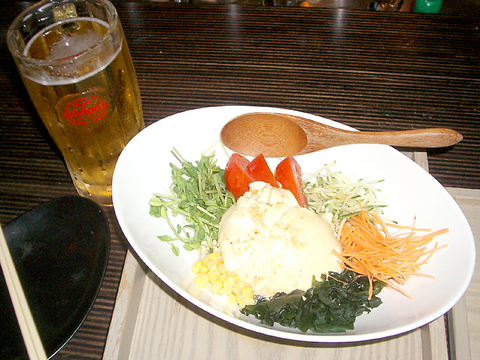Dozo is as good as any contemporary izakaya ("Japanese beer hall") in Tokyo. It is a great place for a meal or light snack and offers similar fare.
Before opening the restaurant in January, the owners spent time researching Japan's bars and eateries, and the decor wasn't the only thing they imported -- the chef was also brought over to ensure authenticity.
The restaurant's genuineness is proven by the number of Japanese patrons who frequent the establishment -- enough to warrant the staff learning Japanese.

PHOTO: DIANA FREUNDL, TAIPEI TIMES
The extensive menu includes all the traditional snack foods one would expect at an izakaya in addition to dishes like omogoieyyuo, often found only at specialty restaurants.
The only disappointment was the missing eda mame (boiled soya beans with salt), which is standard at most Japanese bars.
There are many grilled, deep fried and barbeque meat options as well as the popular sashimi, which can be ordered in small sizes or in assorted combos (NT$260 up to NT$980). The charcoal grilled beef with garlic sauce and the seafood and avocado salad are highly recommended by a few regular customers.
There is also a good selection of vegetable and tofu dishes to satisfy vegetarian and vegan restrictions. The tofu and seaweed salad is made with fresh, soft tofu and served over a bed of greens and savory homemade sesame dressing. It's too good to share.
The okonomiyaki (potato or rice-based pancake) filled with cabbage, carrots, onion and its namesake cream sauce is as tasty as those made in Hiroshima.
The portions are surprisingly large given the reasonable prices. A tofu salad, soba noodles and okonomiyaki was more than enough for two people and under NT$500, leaving extra money for drinks.
There is a separate beverage menu with a range of cocktail concoctions made with green tea or fresh fruit. Economically, beer is the better option with choice of bottled Asahi or pints of Orion draft. A word to the wise: the samurai -- a lethal cocktail -- packs a punch and may make you want to commit ritual suicide the next day.
Operated by the same group that owns TU and Brown Sugar, Dozo's lively atmosphere is more like a trendy Taipei lounge bar than a restaurant.

Oct. 27 to Nov. 2 Over a breakfast of soymilk and fried dough costing less than NT$400, seven officials and engineers agreed on a NT$400 million plan — unaware that it would mark the beginning of Taiwan’s semiconductor empire. It was a cold February morning in 1974. Gathered at the unassuming shop were Economics minister Sun Yun-hsuan (孫運璿), director-general of Transportation and Communications Kao Yu-shu (高玉樹), Industrial Technology Research Institute (ITRI) president Wang Chao-chen (王兆振), Telecommunications Laboratories director Kang Pao-huang (康寶煌), Executive Yuan secretary-general Fei Hua (費驊), director-general of Telecommunications Fang Hsien-chi (方賢齊) and Radio Corporation of America (RCA) Laboratories director Pan
The consensus on the Chinese Nationalist Party (KMT) chair race is that Cheng Li-wun (鄭麗文) ran a populist, ideological back-to-basics campaign and soundly defeated former Taipei mayor Hau Lung-bin (郝龍斌), the candidate backed by the big institutional players. Cheng tapped into a wave of popular enthusiasm within the KMT, while the institutional players’ get-out-the-vote abilities fell flat, suggesting their power has weakened significantly. Yet, a closer look at the race paints a more complicated picture, raising questions about some analysts’ conclusions, including my own. TURNOUT Here is a surprising statistic: Turnout was 130,678, or 39.46 percent of the 331,145 eligible party

The classic warmth of a good old-fashioned izakaya beckons you in, all cozy nooks and dark wood finishes, as tables order a third round and waiters sling tapas-sized bites and assorted — sometimes unidentifiable — skewered meats. But there’s a romantic hush about this Ximending (西門町) hotspot, with cocktails savored, plating elegant and never rushed and daters and diners lit by candlelight and chandelier. Each chair is mismatched and the assorted tables appear to be the fanciest picks from a nearby flea market. A naked sewing mannequin stands in a dimly lit corner, adorned with antique mirrors and draped foliage

The election of Cheng Li-wun (鄭麗文) as chair of the Chinese Nationalist Party (KMT) marked a triumphant return of pride in the “Chinese” in the party name. Cheng wants Taiwanese to be proud to call themselves Chinese again. The unambiguous winner was a return to the KMT ideology that formed in the early 2000s under then chairman Lien Chan (連戰) and president Ma Ying-jeou (馬英九) put into practice as far as he could, until ultimately thwarted by hundreds of thousands of protestors thronging the streets in what became known as the Sunflower movement in 2014. Cheng is an unambiguous Chinese ethnonationalist,